Here are some of the highlights in my opinion:
Charles-Antoine Coypel
"Portrait of Philippe Coypel and his Wife"
1742
Look at the fine detail of the lace, the sheen of the pearls and the texture of the woman's skin.
Rosalba Carriera
"Young Lady with Parrot" 1730
wet chalk and pastels
This is more what I think of when I think of pastels - all the blending, but even still - so much life is able to be put into a pastel work - why don't more people use them?!
Joseph Wright of Derby
"Self Portrait in Fur Cap" 1765/68
This looks like a photograph to me. I'm amazed at what the artist was able to achieve here with monochromatic pastels (grisaille). This is one of my favorites.
Edgar Degas
"On Stage," 1879-81
Confusingly, the plaque next to the painting says that Degas used pastel and essence over monotype on cream laid paper. Any idea what this essence might be? Artists out there? The essence of genius? I wonder if I can get some of that in powder form - like pixie dust.
In other news: Consumers can't do math; Financing for the first high-speed rail in the US has been approved; and you might be able to teach yourself synesthesia!
Happy Fourth of July, Everyone!
.








1 comment:
I see now why you wanted to try out those pastels. Interesting! I read the article about why consumers are bad at math. Interesting stuff. I had heard the issue with using the number '9' in pricing, but everything else was new. Cool stuff!
- Monte
Post a Comment